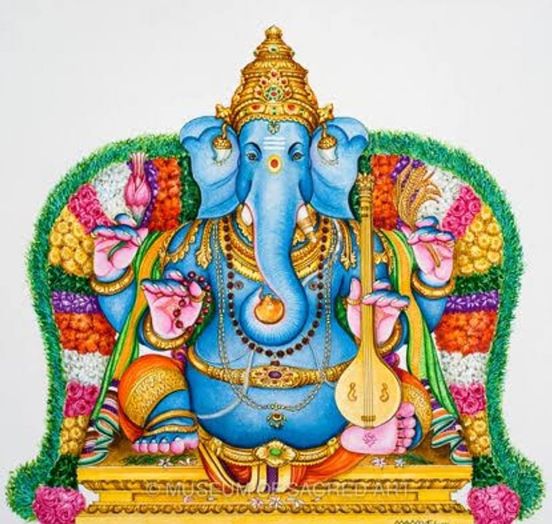Ucchishtha Ganapati Sahasranama and Shankarabhagavatpada
Sri Sankara Bhagavatpada who was immersed in the realization of Oneness with the Supreme, was a great devotee of all the various manifestations of God-head. We see him as the great Ganesh-Bhakta in his Pancha-ratna and Bhujanga on Vinayaka…
In the Sahasranama of Ucchishta Ganapati (also referred to as Guhyanama Sahasraka or the thousand esoteric names) we see Ganapati referred to as the custodian of all the six amnayas of the six maths of Sankara, five of them established in the ter restrial plane, while the sixth belongs to the domain of pure spirit.
The five maths and amnayas are referred to in the following namas (328-337):
कामकोटीपीठवासः, शङ्करार्चितपादुकः, ऋश्यशृङ्गपुरस्थः, सुरेशार्चितवैभवः, द्वारकापीठसंवासः, पद्मपादार्चिताङ्घ्रिकः , जगन्नाथपुरस्थः, तोटकाचार्यसेवितः, ज्योतिर्मठालयस्थः, हस्तामलकपूजितः । and again namas (776-780):
तोटकाचार्यसन्दिष्टपूर्वाम्नायकमन्त्रकः ।
सुरेशसमुपादिष्टदक्षिणाम्नायमन्त्रकः ।
पद्मपादसमादिष्टपश्चिमाम्नायमन्त्रकः ।
हस्तामलक सन्दिष्टोत्तराम्नायकमन्त्रकः ।
शङ्कराचार्यसन्दिष्टोर्ध्वाम्नायाखिलमन्त्रकः ।
– Names which very clearly record that Sri Bhagavatpada established Maths at Kanchi, Sringagiri, Dvaraka, Jagannathapuri and Badari, putting them respectively in charge of himself and his disciples, Suresvara, Padmapada, Totaka and Hastamalaka.
It is also of significance that Ganapati is said to be extolled by all the mantras (Akhila mantrakah) in the Kamakoti Peetham. While each of the other Mathas has one of the four Mahavakyas, Kamakoti has all the four of them.
Later in this Sahasranama, the five pithas are said to signify the five acts of the Lord and Kamakoti in this scheme is the special seat conferring the grace of Liberation (Urdhvamnaya mantroghair anugraha prakasakah).
Guhyanama Sahasraka also speaks of the five Lingas that Sankara got from Siva
विद्याभोगयशोमोक्षयोगलिङ्गप्रतिष्ठितः ।
The names of the five Lingas are given as Vidya, Bhoga, Yaso, Moksha and Yoga Lingas.
In the traditional biographies of Sankaracharya, we have the names Muktilinga and Varalinga in place of Vidyalinga and Yasolinga. Mukti being none other than Moksha the nomenclature of Guhyanama Sahasraka seems more acceptable.
This Sahasranama, occurring in the Uddamarmesa Tantra, one of the 64 tantras, is imparted only to those who have touched the very end of Tantra Upasana. What appears gross and obscene in it, is in reality a symbol of Supreme Enjoyment of Bliss. That is why the layman is not initiated into it. At a very modest estimate, this Sahasranama should have attained its high status at least some four centuries back, since we come to know that the great Sakta of revered memory, Sri Chidanandanatha, is the eighth in the succession of disciples of one of the schools of Ucchishta Ganapati Upasana.
It is of particular interest to know that Shri Sacchidananda Sivabhinava Nrsimha Bharati Sankaracharya Svamiji of Shri Sringeri Peetha was deeply drawn to this Sahasranama.
Sankara’s devotion to Ganapati was very great. When he found the Goddess Akhilandesvari of Tiruvanaikka radiating a fierce aspect that common people could not stand, he not only drew that fierce aspect in the Sri Chakras to be placed in Her ears, but also installed an image of Ganapati in front of Her; because he knew the immense love that Ganapati’s presence would evoke in the Divine Mother.
Fittingly, the Kamakshi temple, which is intricately interwoven with the Kamakoti Peetha, contains a number of images of Ganapati, each with a different name. In his Pentad on Devi, Sankara prays to Kamakshi in each stanza; ” Let the Goddess residing in this Ambapura, mother of Ganapati, protect me” (Mam Ambapuravasini Bhagavati Heramba Mata avatu). It implies that he is entitled to the Divine Mother’s love in an equal measure with Ganapati, beloved of her.
– By Sankara Kinkara – Sankara And Shanmata (1969)

